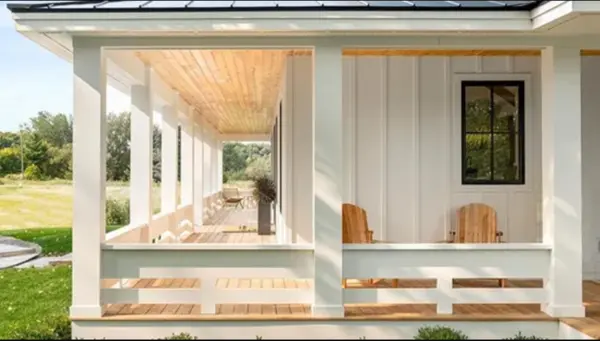Composite decking materials are, if not the finest, among the decking material available for all purposes in the eyes of the vast majority of consumers.
Composite decking is considerably more durable and requires considerably less maintenance, despite its higher initial investment. It is resistant to splitting and deterioration, unlike specialty or pressure-treated woods. As a result, its strategic advantage of long-term value can be strengthened.
Composite decking is made of these items so it is the only material that is low- maintenance and resistant to the weather that is currently available. Being an artistic homeowner, my desire for the deck is to have it look pleasant for years to come. Whether considering the time saved on maintenance or long-term investment costs, composite decking emerges as the superior alternative.

Why is the selection of appropriate decking materials so critical?
Normal decking is usually built of wood or composites, which may also include exotic timbers. To find out the option of the decking material which will be appropriate to your taste and side, it is very essential to engage in thorough research of the different options available, know their advantages and disadvantages as well as the cleaning work needed to prolong the decking’s beauty and longevity.
Upgrading any deck (may it be adding a new one or giving a facelift to an old one) means a lot of work, either way.
Analyze your complete outdoor area before beginning the decking process to determine the most suitable decking material for your yard.
You will establish your deck design concepts through the selection of hues, textures, and materials. Take into account the positioning of your veranda, its vertical extent, the architectural elements of your residence, and any additional property features that you wish to accentuate.
Composite Decking
Composite decking is without a doubt among the finest decking materials. As an alternative to wooden platforms, composite decking has gained significant traction in backyard renovations due to its environmental sustainability and low maintenance requirements. Considerable progress has been made since the days when materials resembled plastic rather than wood.
Presently, composite decking is manufactured utilizing an extensive variety of basic materials, such as bamboo, wood chips, and recycled plastic, among others. 50% wood fibers are incorporated into COOWIN composites, for instance, in order to replicate the appearance of a solid wood deck.
Without requiring sanding or refurbishing, composite decking is remarkably low-maintenance. In most cases, a thorough cleaning or two is all that is normally required as the least amount of annual deck maintenance.
However, while composites are usually the costlier option compared to wooden planks, the omission of having the treated deck to prevent the weather or insects may result in long-term savings. Due to the boards’ high level of resilience, they would only minorly fade appearance-wise over time.
Pressure Treated Wood
The most affordable option among the leading decking materials is this one. This option is suitable for individuals who are not concerned with routine maintenance. Pressure-treated wood is the most widely use variety of wood decking. Although treatment varies among timber types, pressure-treated lumber is chemically saturated with anti-rot and insecticides, thereby enhancing its inherent resistance.
Additionally, it is simple to locate, trim, and manipulate in a general sense. A stain can conceal the natural color of pressure-treated wood, thereby increasing its aesthetic allure, if you dislike it. While allowing your deck to weather for several months before staining is generally the best course of action, there are certain benefits to sanding beforehand.
Additionally, it is noteworthy that treated timber is available in a variety of grades; your local supplier may be able to guide you in choosing the one that suits your budget the best. The most noticeable distinction between composite and wood decking is how traditional wood fissures, warps, or fractures.
Additionally, pressure-treated timber requires regular maintenance. However, with appropriate maintenance, such as re-staining, power washing, and sanding. The life of a pressure-treated deck could potentially be extend. Wood that has been pressure-treat costs between $15 and $35 per square foot. Which makes it one of the most cost-effective decking materials.
Comparing Composite to Wood
Numerous householders opt for wood due to its widespread use, low cost, and accessibility. Concurrently, wood deck issues such as splinters, decay, and excessive maintenance give rise to a multitude of problems.
While composite decks offer the advantage of reduced maintenance costs. Certain householders express apprehension regarding their potential inferior aesthetics in comparison to wooden decks. Nevertheless, advancements in the industry have produced composite materials. That resembles wood in appearance while eliminating the hassles associated with the upkeep of a wooden deck.
Let’s examine which decking material is optimal for each of the following critical concerns:
The Looks
In contrast to the synthetic and contrived appearance of early composite decks. Certain contemporary composites feature a randomized embossed grain pattern that distinguishes each board. COOWIN composites consequently resemble wood deck planks.
Moisture content
A significant drawback associated with wooden decks is the propensity of the planks to accumulate water. Failure to regularly apply sealants, stains, or paint can result in wood decking experiencing deterioration such as splintering, splitting, warping, and discoloration.
Because the core of composite decking products is completely resistant to moisture. They can install in high-moisture environments without deteriorating.
Price
Among the various merits and demerits of timber decks, the expense is unquestionably advantageous. In many cases, it is more affordable to acquire than composite decking, especially when purchasing for the first time.
In contrast to the comparatively lower initial investment required for timber. Composite materials frequently recoup their investment within two to three years with yearly